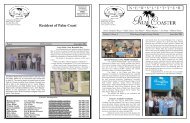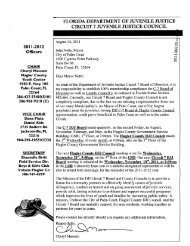Swimming Pool Safety - City of Palm Coast
Swimming Pool Safety - City of Palm Coast
Swimming Pool Safety - City of Palm Coast
You also want an ePaper? Increase the reach of your titles
YUMPU automatically turns print PDFs into web optimized ePapers that Google loves.
Childhood<br />
Home<br />
<strong>Safety</strong><br />
Most Drowning incidents occur in<br />
residential pools; however young<br />
children can drown in less than two<br />
inches <strong>of</strong> water.<br />
Most Childhood<br />
drowning deaths<br />
occur when the<br />
parent or caregiver<br />
becomes distracted by<br />
the telephone,<br />
doorbell or chores<br />
around the home.<br />
Children can drown in a<br />
matter <strong>of</strong> seconds. If a child is<br />
missing, check the water first!<br />
Drowning is the leading cause <strong>of</strong><br />
unintentional injury related death in<br />
children ages one to four.<br />
Entrapment Protection Requirements<br />
According to Florida Building Code section 424.2, all<br />
pools must have an entrapment prevention system.<br />
Entrapment prevention details and construction will be<br />
checked to verify meeting one <strong>of</strong> the following methods:<br />
Florida sealed engineering for a vent piping system<br />
that relieves the vacuum to less than 4.5” <strong>of</strong> mercury<br />
in 3 seconds or less. Details will list dimensions and<br />
installation specifications and calculations.<br />
An approved vacuum relief device designed to meet<br />
IAPMO IGC 160-2001a.<br />
Or other approved means.<br />
These devices can be easily and quickly installed on<br />
any existing or new swimming pool or spa and provide<br />
two “layers <strong>of</strong> protection”.<br />
www.ci.palm-coast.fl.us<br />
<strong>Swimming</strong><br />
<strong>Pool</strong> <strong>Safety</strong><br />
Builing Division<br />
160 Cypress Point Pkwy<br />
Suite B-106<br />
<strong>Palm</strong> <strong>Coast</strong>, Fl 32164<br />
386-986-3780 (<strong>of</strong>fice)<br />
386-986-3781 (fax)
The Florida Legislature finds that drowning is the leading<br />
cause <strong>of</strong> death <strong>of</strong> young children in this State and<br />
is also a significant cause <strong>of</strong> death for<br />
medically frail elderly persons in this State,<br />
that constant adult supervision is the key to<br />
accomplishing the objective <strong>of</strong> reducing the<br />
number <strong>of</strong> submersion incidents, and that<br />
when lapses in supervision occur a pool safety feature<br />
designed to deny, delay, or detect unsupervised entry<br />
to the swimming pool, spa, or hot tub will reduce<br />
drowning and near-drowning incidents.<br />
Therefore, it is the intent <strong>of</strong> the Legislature that all new<br />
residential swimming pools, spas, and hot tubs be equipped<br />
with at least one pool safety feature.<br />
A person who fails to equip a new residential<br />
swimming pool with at least one pool safety<br />
feature as required in subsection (1) commits<br />
a misdemeanor <strong>of</strong> the second degree, punishable<br />
as provided in s. 775.082 or s. 775.083,<br />
except that no penalty shall be imposed if the person,<br />
within 45 days after arrest or issuance <strong>of</strong> a summons or a<br />
notice to appear, has equipped the pool with at least one<br />
safety feature as required in subsection (1) and has attended<br />
a drowning prevention education program established<br />
by s. 515.31. However, the requirement <strong>of</strong> attending<br />
a drowning prevention education program is waived if<br />
such program is not <strong>of</strong>fered within 45 days after issuance<br />
<strong>of</strong> the citation.<br />
A final inspection is required before the<br />
swimming pool / spa/ hot tub<br />
can be occupied.<br />
<strong>Pool</strong> safety requirements AND city<br />
landscaping requirements (to include sod)<br />
must be met in order to receive<br />
a passing final inspection.<br />
<strong>Swimming</strong> <strong>Pool</strong> <strong>Safety</strong> Information<br />
RESIDENTIAL SWIMMING POOL SAFETY ACT<br />
Florida Statute Chapter 515 (excerpt)<br />
The pool must be isolated from access to a home by an<br />
enclosure that meets the pool barrier requirements<br />
listed below.<br />
The pool must be equipped with an approved safety<br />
pool cover.<br />
All doors and windows providing direct access from<br />
the home to the pool must be equipped with an<br />
exit alarm that has a minimum sound pressure<br />
rating <strong>of</strong> 85 dB A at 10 feet; or<br />
All doors providing direct access from the home to the<br />
pool must be equipped<br />
with a self-closing,<br />
self-latching device with a<br />
release mechanism placed<br />
no lower than 54 inches<br />
above the floor.<br />
A residential swimming pool barrier must have all <strong>of</strong><br />
the following characteristics:<br />
The barrier must be at least 4 feet high on the outside.<br />
The barrier may not have any gaps, openings,<br />
Indentations, protrusions, or structural<br />
components that could allow a young child to<br />
crawl under, squeeze through, or climb over the<br />
barrier.<br />
The barrier must be placed around the perimeter <strong>of</strong> the<br />
pool and must be separate from any fence, wall, or<br />
other enclosure surrounding the yard unless the<br />
fence, wall, or other enclosure or portion there<strong>of</strong> is<br />
situated on the perimeter <strong>of</strong> the pool, is being<br />
used as part <strong>of</strong> the barrier, and meets the barrier<br />
requirements <strong>of</strong> this section.<br />
The barrier must be placed sufficiently away from the<br />
water's edge to prevent a young child or medically<br />
frail elderly person who may have managed to<br />
penetrate the barrier from immediately falling into<br />
the water.<br />
The structure <strong>of</strong> an above ground<br />
swimming pool may be used as its<br />
barrier or the barrier for such a pool<br />
may be mounted on top <strong>of</strong> its<br />
structure; however, such structure or<br />
separately mounted barrier must meet all barrier<br />
requirements <strong>of</strong> this section. In addition, any ladder<br />
or steps that are the means <strong>of</strong> access to an<br />
aboveground pool must be capable <strong>of</strong> being secured,<br />
locked, or removed to prevent access or must be<br />
surrounded by a barrier that meets the requirements<br />
<strong>of</strong> this section. (This is for state barrier requirements<br />
only, the city will require separate BUFFER<br />
requirements for above ground pools)<br />
Gates that provide access to swimming pools must<br />
open outward away from the pool and be self<br />
-closing and equipped with a self-latching locking<br />
device, the release mechanism <strong>of</strong> which must be<br />
located on the pool side <strong>of</strong> the gate and so placed<br />
that it cannot be reached by a young child over the<br />
top or through any opening or gap.<br />
A wall <strong>of</strong> a dwelling may serve as part <strong>of</strong> the barrier<br />
if it does not contain any door or window that<br />
opens to provide access to the swimming pool.<br />
A barrier may not be located in a way that allows<br />
any per-<br />
For more information on<br />
Florida <strong>Pool</strong> <strong>Safety</strong><br />
go online to<br />
www.fpsaonline.org








